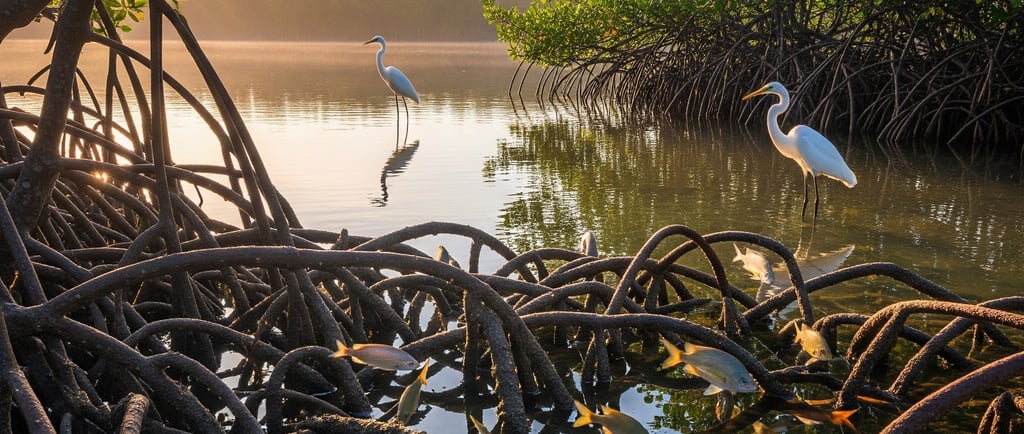The Secret Life of Mangroves
Uncovering Florida's Coastal Ecosystems
Gabriel Alvarez, Ranger
7/31/20254 min read


Florida's coastline, a vibrant tapestry of sun-drenched beaches and bustling estuaries, harbors a foundational ecosystem often overlooked but profoundly vital: the mangrove forests. These remarkable trees, thriving where land meets sea, are far more than just green fringes; they are dynamic architects of coastal stability, nurseries for marine life, and powerful guardians against the forces of nature. Through the lens of environmental interpretation, we can truly begin to appreciate the intricate biology, ecological significance, and rich history embedded within these unique coastal sentinels.
A Legacy Rooted in Saltwater
The history of mangroves in Florida is inextricably linked to the very formation and sustenance of its distinctive coastline. For millennia, these hardy trees have anchored themselves in brackish waters, slowly expanding landmasses by trapping sediments and decaying organic matter. Their presence predates modern human settlement, shaping the very geography that now defines much of South Florida. Indigenous tribes like the Calusa understood and utilized these rich coastal environments, benefiting from the abundance of marine life supported by mangrove habitats.
Ecologically, mangroves are the quintessential "ecotones". An ecotone is a transition area between two biological communities, where species from both overlapping communities, as well as unique ecotone species, thrive. In this case, mangroves bridge terrestrial and marine environments, creating a unique intertidal zone that supports an extraordinary diversity of life. They are critical to the health of estuaries, serving as natural water filtration systems that remove pollutants and excess nutrients from runoff before it reaches larger bodies of water. This cleansing action helps maintain water clarity, which is essential for seagrass beds and coral reefs located further offshore.
The Architects of the Coastline
What enables mangroves to flourish in conditions that would prove fatal to most other plants? Their success lies in a suite of remarkable biological adaptations to highly saline, low-oxygen environments.
Firstly, mangroves possess specialized mechanisms for dealing with salt. Some species, like the red mangrove, actively exclude salt at their roots, acting as a sophisticated filtration system3. Others, such as the black mangrove, absorb salt and then excrete it through glands on their leaves, often visible as salt crystals on the leaf surface. This unique physiological machinery allows them to thrive where freshwater plants cannot compete.
Secondly, the anaerobic (oxygen-poor) conditions of soggy coastal soils are overcome by specialized root systems. Many mangroves develop aerial roots that extend above the waterline to absorb oxygen directly from the atmosphere. These include:
Prop Roots (Red Mangrove): Arching, stilt-like roots that grow down from the trunk and branches, providing stability in soft sediments and a maze-like habitat for marine organisms.
Pneumatophores (Black Mangrove): Vertical, pencil-like projections that emerge from the soil around the base of the tree, acting like snorkels to transport oxygen to the buried root system.
Finally, mangroves exhibit a unique reproductive strategy called viviparity, where seeds germinate while still attached to the parent tree. These elongated seedlings, or propagules, drop from the tree and can float for long distances in saltwater until they find suitable, shallow mudflats to root and grow. This ensures successful colonization of new areas and resilience against tidal forces.
Distinguishing Florida's Mangrove Trio: Red, Black, and White
Florida is home to three primary mangrove species, each occupying a slightly different zone within the intertidal ecosystem, creating distinct zonation patterns along the coastline. Learning to identify them enhances our appreciation for their ecological roles.
Red Mangrove (Rhizophora mangle): Often found closest to the water's edge, the red mangrove is easily recognized by its distinctive, arching prop roots. These reddish-brown, often reddish-tinged, roots create dense tangles that stabilize shorelines, dissipate wave energy, and provide critical hiding places and foraging grounds for juvenile fish, crabs, and other marine invertebrates. Its leaves are typically elliptical, smooth, and dark green, often with a pointed tip. Its viviparous propagules are long, cigar-shaped, and green, dangling from the branches before dropping.
Black Mangrove (Avicennia germinans): Typically found landward of the red mangroves, in slightly higher elevations that are inundated by tides less frequently, the black mangrove is characterized by its numerous, upright pneumatophores. These "breathing tubes" emerge vertically from the muddy soil around the tree's base, appearing like a field of pencils. Its leaves are dark green on top and often silvery-grey underneath due to salt glands that excrete excess salt, making the leaves appear dusty or even crystalline. Its bark is dark and often furrowed.
White Mangrove (Laguncularia racemosa): Occupying the highest elevations of the three, typically found furthest from the water and often alongside other upland vegetation, the white mangrove lacks the prominent prop roots or pneumatophores of its cousins. It has small, oval-shaped leaves with two tiny, sugar-secreting glands (nectaries) at the base of the leaf blade where it meets the stem. These glands are a key identifier and attract insects. While it can develop small pneumatophores in very wet conditions, they are less pronounced than those of the black mangrove. Its bark is typically light-colored and smooth.
Interconnectedness
The ecological significance of mangroves extends far beyond their immediate canopy and roots. They are the linchpin of a broader coastal food web and provide invaluable services to both wildlife and human communities.
Their dense root systems and submerged branches act as critical nurseries for juvenile fish, crustaceans, and shellfish, offering protection from predators and abundant food sources. Snook, snapper, tarpon, and various species of crab and shrimp rely on mangrove habitats during their early life stages. This direct link makes mangroves vital to Florida's commercial and recreational fisheries. Wading birds, raptors, and countless other avian species utilize mangroves for nesting, roosting, and foraging. The unique Indian River Lagoon dolphin subspecies, for example, relies on the health of the lagoon system that mangroves help to sustain.
For human communities, mangroves provide indispensable ecosystem services. They protect coastlines from erosion, absorb the impact of storm surges and hurricanes, and filter pollutants, safeguarding water quality for recreation and consumption. They are nature's own formidable seawalls, providing protection and resiliency that engineered structures often cannot match.
Protecting Our Coastal Jewels
The secret life of mangroves reveals an ecosystem of remarkable resilience, intricate adaptations, and profound ecological value. Their history is intertwined with Florida's past, and their health is crucial for its future. As stewards of these vital coastal jewels, understanding their unique biology and ecological contributions empowers us to ensure their continued protection and flourishing for generations to come. By supporting conservation efforts and adhering to environmentally safe practices, we safeguard not just a forest, but the very pulse of Florida's vibrant coastal life.
-Gabriel Alvarez, Lee County Ranger
Disclaimer: This blog post was created with the help of AI.
